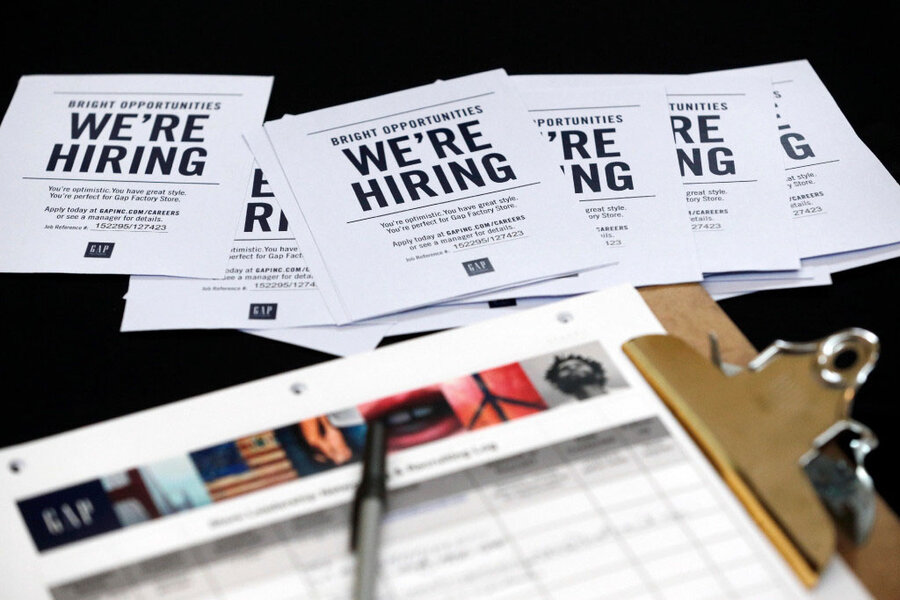After robust start to 2017, US hiring sputters in March
Loading...
The US economy roared into 2017, adding 238,000 jobs in January and 235,000 jobs in February. But with the Labor Department's March unemployment report, released on Friday, that strong start seems to be sputtering.
Economists had expected that hiring would cool off, projecting an increase of about 180,000 new jobs. But the Bureau of Labor Statistics’s establishment survey fell short of even that projection, finding that total nonfarm payroll increased by just 98,000 jobs last month. (Its household survey showed a 326,000-person drop in unemployment, but economists consider the establishment survey, which has a larger sample size and focuses on employers, to be a more accurate measure.)
Last month’s hiring dip was likely felt by many of the 7.2 million Americans currently unemployed. But while March’s employment results were disappointing, they don’t mean that the nation's long-running pattern of job growth has ended.
“I think it's a little bit surprising ... that it came in as low as 98 [thousand],” says Elise Gould, senior economist at the Economic Policy Institute (EPI). “I expect that it's a slip, and that we will see more on-trend numbers next month.”
In a phone interview with The Christian Science Monitor, Dr. Gould identifies one possible – and surprising – reason for the drop. The projections economists use, she explains, are “not built to take deviations in the weather.”
The weather has seen plenty of deviations from the norm this winter, from record-breaking warmth in February to a major Northeast blizzard in early March. Both could have shifted economic trends; warmer-than-usual winter weather, for instance, means that construction sites can stay open and that more potential shoppers and home-buyers may feel inclined to venture outside.
On the flipside, a big snowstorm can close workplaces and put a damper on those activities. In an email to the Monitor, Mark Hamrick, Bankrate.com’s senior economic analyst, noted that “construction employment slowed in March with 6,000 jobs added after nearly 10 times that number reported hired the month before. Weather may have whipped some of these numbers around a bit.”
Gould also points out that last month’s big storm “happened during a reference week” for the BLS survey, and adds, “there's some history of March being softer in general” for job growth. For instance, March hiring also slacked off in 2016 and 2015, The New York Times reports.
To be sure, weather isn’t the only factor affecting job seekers’ prospects. Structural changes in the economy, such as automation and outsourcing, are continuing to erase yesterday’s low-skilled positions. Hamrick highlighted one instance of this trend in discussing the March report. A wave of recent chain-store closings – driven by competition from e-commerce firms – drove a loss of nearly 30,000 retail jobs.
In a sign that many Americans still don’t see reason to even look for jobs, the labor force participation rate remained unchanged from February at 63 percent – more than 4 percentage points below its 2000 levels. This smaller pool of potential workers – not just new hiring – is helping keep the unemployment rate at a remarkably low 4.5 percent.
And while those with jobs saw their wages increase by an average of 2.7 percent, Hamrick says that’s below the “3 percent level that we’d associate with a stronger recovery,” or a “tight” labor market.
Gould agrees. "I think we're still seeing a situation where employers don't have to ... make huge [wage] increases to attract and retain the workers they want."
Despite these less-than-encouraging numbers, it’s worth remembering that the United States has already come a long way since the Great Recession. According to the EPI’s autopilot economy tracker, the share of the prime-age population (ages 25-54) with a job has reached 78.5 percent – its highest level since September 2008, and well above the 74.8 percent it hit in December 2009.
At least for the moment, though, that recovery seems to have hit a slowdown.
“While we're moving towards full employment,” Gould says, “we are still not there yet.”








